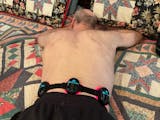The Role of Red Light Therapy in Sports Recovery
Red light therapy (RLT) is gaining recognition as a valuable tool in sports recovery and performance enhancement. In this blog post, we explore the specific benefits of red light therapy for athletes and active individuals, backed by scientific evidence and practical applications.
How Red Light Therapy Works in Sports Recovery
Red light therapy utilizes specific wavelengths of light, typically in the red and near-infrared spectrum, to penetrate tissues and stimulate cellular processes. This interaction with mitochondria enhances ATP production, reduces oxidative stress, and promotes cellular repair and regeneration. These mechanisms play a crucial role in supporting faster recovery from intense physical activity and sports-related injuries.
Benefits of Red Light Therapy for Athletes
Accelerated Muscle Recovery: After strenuous exercise or injury, muscles can benefit from RLT's ability to reduce inflammation and oxidative stress. Studies have shown that RLT enhances muscle repair processes, leading to quicker recovery times and reduced muscle soreness.
Pain Relief: Athletes often experience muscle and joint pain due to training or competitive activities. RLT has analgesic effects by modulating pain pathways and promoting natural pain relief mechanisms, making it an effective complementary therapy for pain management.
Enhanced Performance: Regular use of RLT has been linked to improvements in athletic performance metrics such as strength, endurance, and speed. By optimizing cellular function and metabolic processes, RLT helps athletes maintain peak performance levels.
Scientific Evidence and Studies
Recent research supports the efficacy of RLT in sports recovery:
-
A study published in the Journal of Athletic Training (2023) demonstrated that athletes treated with RLT showed significant improvements in muscle recovery and performance compared to control groups.
-
Research from the American College of Sports Medicine (2022) highlighted RLT's ability to reduce muscle fatigue and improve exercise tolerance in athletes undergoing intense training regimens.
Practical Applications and Considerations
Treatment Protocols: Optimal RLT protocols for sports recovery typically involve sessions before or after training sessions or competitions. The duration and frequency of treatments may vary based on individual needs and the intensity of physical activity.
Combination Therapies: RLT can be integrated with other modalities such as cryotherapy or massage therapy to enhance recovery outcomes. This synergistic approach addresses multiple aspects of recovery, including inflammation reduction and muscle relaxation.
Conclusion
Red light therapy represents a promising approach to enhancing sports recovery and optimizing athletic performance. Its ability to accelerate muscle recovery, alleviate pain, and support overall well-being makes it a valuable tool for athletes of all levels. Explore our range of advanced red light therapy devices tailored for sports recovery and experience the benefits of this innovative technology firsthand. Stay ahead in your game with red light therapy—where science meets sports excellence.
By incorporating RLT into your training regimen, you can unlock the potential for faster recovery, reduced injury risk, and enhanced athletic performance. Join athletes worldwide in leveraging the power of red light therapy for peak sports performance and optimal recovery.
















Share:
Understanding Red Light Therapy and Its Therapeutic Benefits
Health Benefits of Red Light Therapy: Boosting Immunity and Promoting Cellular Repair